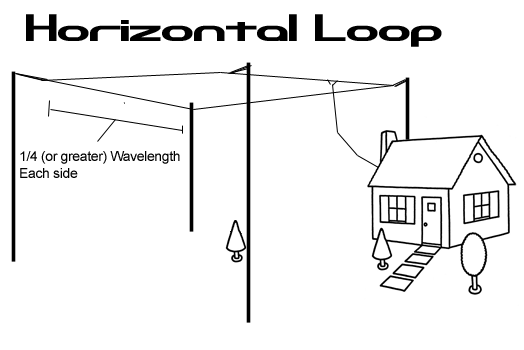Loop antenna
There are two types of loop antennas: small loops and large loops. The key difference between the two is that in a small loop, the current is approximately in phase at all points around the loop, while in a large loops the phase varies at different points. The two types of antenna have very different properties and are used for different purposes.
Small Loops
Main article: small tuned loop
A common saying in antenna design circles is "small, efficient, broadband: pick any two". As their name implies, small loops are small and reasonably efficient, but they are necessarily narrowband antennas. This means that even small changes in frequency require retuning the antenna.
Short linear antennas, whether horizontal or vertical, have capacitive reactance and require an inductor for tuning. small loops are just they opposite; they have significant inductive reactance, and require a capacitor for tuning. Most small loops use a variable capacitor, allowing the antenna to be tuned over a wide range (5 MHz - 15 MHz is easily accomplished).
Small loop antennas have a perimeter of no more than 0.12 λ. (Remember that λ is the symbol for wavelength.) They are normally mounted in the vertical plane.
This type of antenna has very sharp nulls at right angles to the plane of the loop. These nulls can be very useful for suppressing QRM from a local source. Simply rotate the loop until the interference can no longer be heard. Because the nulls are sharp, small changes in antenna orientation can make a large change in signal or noise received from the direction of the nulls. The nulls are sharpest on the smallest loops (perimeter approximately 0.05 λ, and gradually broaden as the perimeter increases to 0.1 λ and beyond.
Large Loops
Large loop antennas have a perimeter of at least 1/2 λ, but they develop significant gain when increased to 1 λ or 2 λ. Large loops are normally mounted in the horizontal plane.
Quads
Quad antennas are essential multiple large loops mounted near each other, with one of them fed and the others used as passive elements. Quads can achieve significant gain. They have more theoretical gain than the commonly used yagis, but they're harder to build since they require significantly more room and are a bit more sensitive so many people just opt for building yagis instead.
| Antennas | |
| Design | Beam * Dipole * Dish or Parabola * DDRR * Log Periodic (LPDA) * Loop * Mobile and portable * Omnidirectional * Panel * Quad and Quagi * Screwdriver * Small tuned loop * Vertical * Yagi-Uda * Wire and random wire antennas |
| Installation | Antenna Tuners * Capacity hats and loading coils * Cavity filters * Coaxial Cable * Feedlines * Rotators * Towers and Masts * VK2ACY - G5RV coupler |
| Theory | Front-to-back ratio * Impedance matching * SWR * Tower design * Vertical Antenna efficiency * Wire comparison tables |
